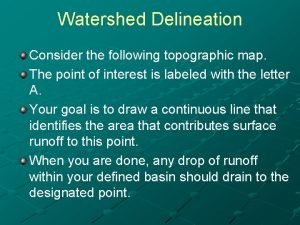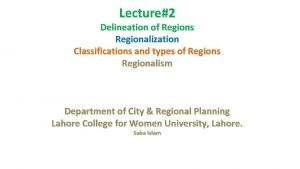Delineation of groundwater potential zones and zones of

- Slides: 1

Delineation of groundwater potential zones and zones of groundwater quality suitable for domestic purposes using remote sensing and GIS 2, A. M. MILEWSKI 3 and R. GLOAGUEN 4 M. El MOULAT 1, A. FEKRI 1, A. E. FRYAR techniques 1 Department of Geology, Faculty of Sciences Ben M'sik Casablanca, Morocco. Email: m. elmoulat@gmail. com and ahmedfekri 1@gmail. com 2 Department of Earth and Environmental Sciences, University of Kentucky. Email: alan. fryar@uky. edu 3 Department of Geology, University of Georgia, Athens, GA 30602. Email : milewski@uga. edu 4 Institute for Geology, Freiberg University of Mining and Technology, 09599, Freiberg, Germany. Email : gloaguen@geo. tu-freiberg. de Introduction Results In the area of Morocco known as the Lower Chaouia occurs in a hard rock terrain, especially the Precambrian quartzite and fractured schist. The groundwater resources are poorly known, and the search for water is randomly treated. To overcome this problem, we developed a map of groundwater potential which will guide the mobilization of additional resources to meet the growing demand for water; for irrigation as well as for domestic purposes. Remote sensing, image processing and GIS provide many required data to cover a large area in short time. Thanks to Those efficient tools, various maps have been designed such as the lineaments, drainage, soil type, slope, elevation and the lithology. The groundwater availability is qualitatively classified into five classes (Excellent, good, moderate, poor and nil). Input Data § Develop a GIS model that can identify groundwater potential zones based on thematic maps applicable across Lower Chaouia. ASTER Existing maps Land. Sat ETM+ Digital Soil Map Editing & adjustement Geoprocessing Digitizing Thematic maps Elevation, lithology, Soil, Slope, Drainage, Lneament. Objectives § Delineate the groundwater potential zones using relevant data (lineaments, drainage, soil type, slope, elevation and the lithology ), Methodology Integration to GIS & Spatial Analysis Conclusion Remotely sensed data from satellite imagery provided information used to identify and outline geology, lineament features, geomorphological and hydromorphogeological conditions. These features served as either direct or indirect indicators of groundwater occurrence. The comprehensive use of GIS resulted in the development of an efficient and effective methodology of spatial data management and manipulation. The integration and analysis of various thematic maps and image data were useful for the delineation of zones of groundwater potential and zones of groundwater quality suitable for domestic purposes. Groundwater Potential Map

